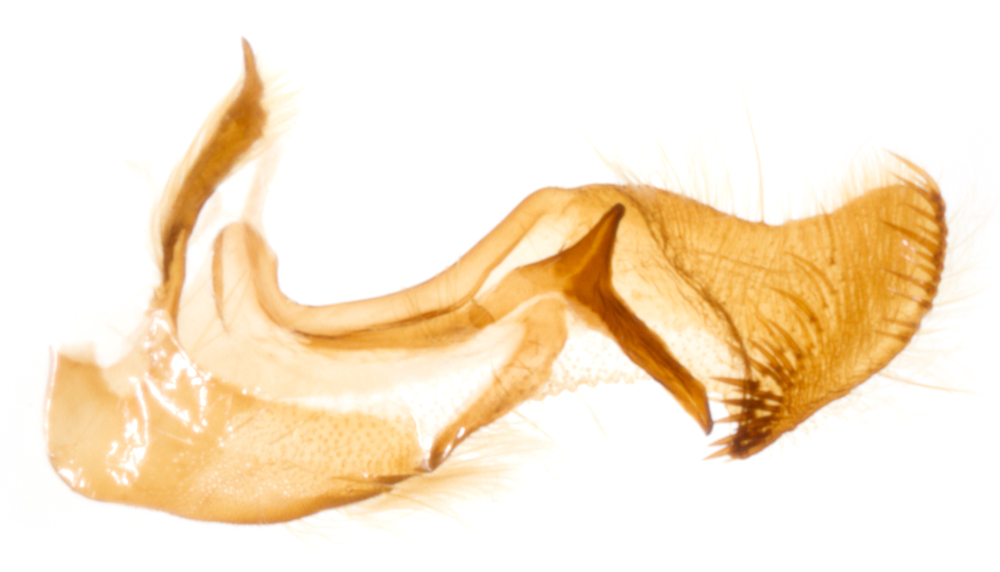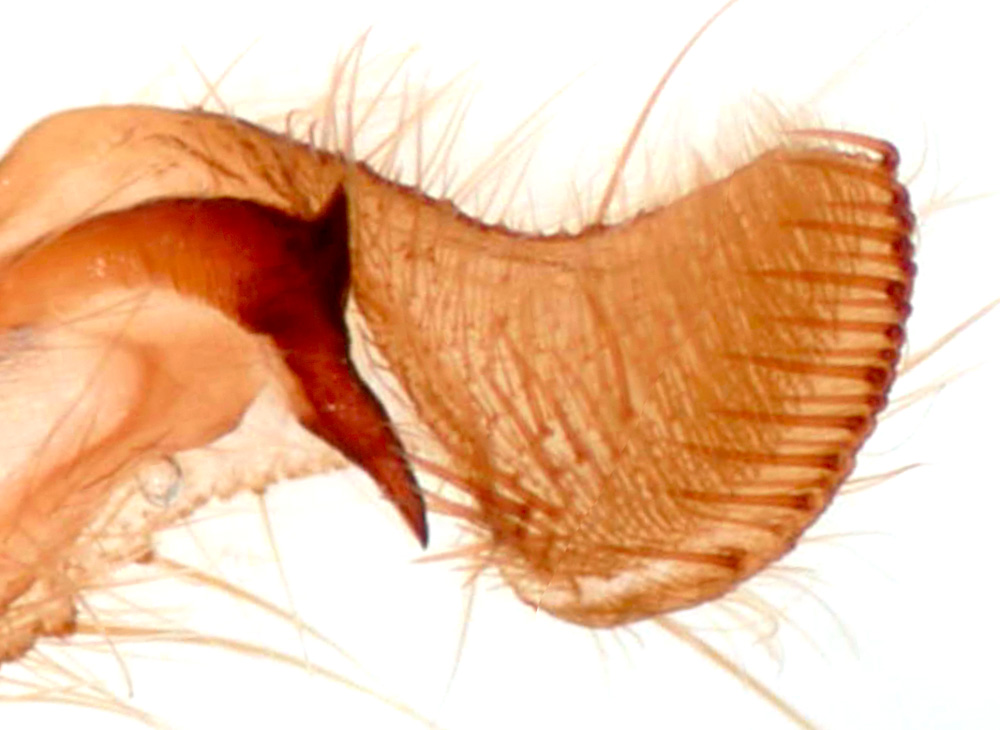Amphipoea
|
Refs: Difficult Species Guide (DSG), Moth Dissection (MD), Waring & Townsend, MBGBI10
The four species are very similar and similarly variable. Where they occur together they cannot be reliably separated without genital examination. Not all specimens of A.fucosa/A.lucens can be separated and both DSG and MD question whether they should be regarded as separate species.
The series of ~6 cross-lines is a good feature for distinguishing them from Helotropha leucostigma (Crescent).
Mesapamea secalis/didyma (Common/Lesser Common Rustic) have a rounded forewing apex (more pointed in Amphipoea species).
Size: A.fucosa/lucens average larger than A.oculea/crinanensis – fw 14-16mm, 14-17mm, 12-15mm, 13-15mm respectively.
Distribution: A.fucosa is largely coastal in saltmarsh and sand-dunes; A.lucens is found on wet acid moorland; A.oculea is more widespread and is the most likely species to find inland in S.England and A.crinanensis is unlikely in S or E.England.
Hindwing underside: The following are trends rather than diagnostic - A.lucens - conspicuous dark discal spot and wavy postmedian line;
A.fucosa - plain or with a weak slightly wavy postmedian line; A.oculea/A.crinanensis - narrow evenly curved postmedian line.
The four species are very similar and similarly variable. Where they occur together they cannot be reliably separated without genital examination. Not all specimens of A.fucosa/A.lucens can be separated and both DSG and MD question whether they should be regarded as separate species.
The series of ~6 cross-lines is a good feature for distinguishing them from Helotropha leucostigma (Crescent).
Mesapamea secalis/didyma (Common/Lesser Common Rustic) have a rounded forewing apex (more pointed in Amphipoea species).
Size: A.fucosa/lucens average larger than A.oculea/crinanensis – fw 14-16mm, 14-17mm, 12-15mm, 13-15mm respectively.
Distribution: A.fucosa is largely coastal in saltmarsh and sand-dunes; A.lucens is found on wet acid moorland; A.oculea is more widespread and is the most likely species to find inland in S.England and A.crinanensis is unlikely in S or E.England.
Hindwing underside: The following are trends rather than diagnostic - A.lucens - conspicuous dark discal spot and wavy postmedian line;
A.fucosa - plain or with a weak slightly wavy postmedian line; A.oculea/A.crinanensis - narrow evenly curved postmedian line.
Male Genitalia:
A.fucosa/A.lucens: Costal process with 2 arms, one much longer than the other*
A.oculea: Costal process with 2 arms of approximately equal length **
A.crinanensis: Costal "process" a serrate dome with no arms (the clavus is also noticeably more robust that in the other 3 species)
* In A.lucens the long arm of the process extends to or beyond the angle of the cucullus and the short arm is narrow and curved. In A.fucosa the long arm of the process doesn't reach the angle of the cucullus and the short arm is broad and stumpy. In both species there two rows of cucullar spines; one row runs from the apex of the cucullus along its margin, the other from the angle of the cucullus across its surface. In A.fucosa these two rows overlap, in A.lucens the surface row is short and the two rows do not overlap. Some specimens are intermediate and indeterminate. MBGBI10 & Waring & Townsend suggest that hybridisation occurs in W.Scotland (see my specimens from Skye).
**This statement needs some refinement. The arms are dorsal and lateral according to DSG; although the shorter arm is dorsal, the longer arm may be better described as ventral. Although the arms could be described as 'roughly equal' in length when compared with A.fucosa/A.lucens, the length of the ventral arm (at least) seems somewhat variable and the dorsal arm may be clearly shorter. The dorsal arm also appears shorter than it is (relative to the ventral arm) in photos, because it is set at an angle with the plane of the valva (ie it is foreshortened). There is also some problem in determining the exact origin of the dorsal and ventral arms in order to assess whether one is longer than the other.
A.fucosa/A.lucens: Costal process with 2 arms, one much longer than the other*
A.oculea: Costal process with 2 arms of approximately equal length **
A.crinanensis: Costal "process" a serrate dome with no arms (the clavus is also noticeably more robust that in the other 3 species)
* In A.lucens the long arm of the process extends to or beyond the angle of the cucullus and the short arm is narrow and curved. In A.fucosa the long arm of the process doesn't reach the angle of the cucullus and the short arm is broad and stumpy. In both species there two rows of cucullar spines; one row runs from the apex of the cucullus along its margin, the other from the angle of the cucullus across its surface. In A.fucosa these two rows overlap, in A.lucens the surface row is short and the two rows do not overlap. Some specimens are intermediate and indeterminate. MBGBI10 & Waring & Townsend suggest that hybridisation occurs in W.Scotland (see my specimens from Skye).
**This statement needs some refinement. The arms are dorsal and lateral according to DSG; although the shorter arm is dorsal, the longer arm may be better described as ventral. Although the arms could be described as 'roughly equal' in length when compared with A.fucosa/A.lucens, the length of the ventral arm (at least) seems somewhat variable and the dorsal arm may be clearly shorter. The dorsal arm also appears shorter than it is (relative to the ventral arm) in photos, because it is set at an angle with the plane of the valva (ie it is foreshortened). There is also some problem in determining the exact origin of the dorsal and ventral arms in order to assess whether one is longer than the other.
Female genitalia:
A.fucosa/A.lucens: Posterior margin of ostium bursae with rounded lobes separated by a shallow rounded notch*
A.oculea: Posterior margin of ostium forms a shallow V
A.crinanesis: Posterior margin of ostium deeply cleft
* DSG & MD separate these on fairly subtle features of the anal papillae and the junction of the ductus and corpus bursae. Both species show a lateral indentation towards the anterior end of the anal papillae, this depression is deeper in A.fucosa. Both species show 2 prominences at the junction of the ductus and corpus bursae, one on the right and slightly more anteriorly on the left. DSG indicates a difference in the right sided prominence (referring to it as the 'basal prominence' or 'shoulder') and states that in A.fucosa it is slightly larger. MD indicates a difference in the left sided prominence suggesting that in A.lucens it is larger. The same image is used for A.lucens in both references, but they use different images for A.fucosa. While at MD the left sided prominence is clearly larger in A.lucens, in the images at DSG the situation is much less clear. I conclude (pending evidence from further material) that the proposed difference in the left sided prominence is completely unreliable, the difference in the right sided prominence is too marginal to be useful and the difference in the anal papillae is unconvincing.
In the images below the specimen of A.lucens was taken well inland, along with several definite male A.lucens, so I am fairly confident of this ID. The specimen of A.fucosa was taken at a coastal site with saltmarsh, but I am less confident of the ID - I will seek females from Foulness (where all males examined have proved to be A.fucosa.
A.fucosa/A.lucens: Posterior margin of ostium bursae with rounded lobes separated by a shallow rounded notch*
A.oculea: Posterior margin of ostium forms a shallow V
A.crinanesis: Posterior margin of ostium deeply cleft
* DSG & MD separate these on fairly subtle features of the anal papillae and the junction of the ductus and corpus bursae. Both species show a lateral indentation towards the anterior end of the anal papillae, this depression is deeper in A.fucosa. Both species show 2 prominences at the junction of the ductus and corpus bursae, one on the right and slightly more anteriorly on the left. DSG indicates a difference in the right sided prominence (referring to it as the 'basal prominence' or 'shoulder') and states that in A.fucosa it is slightly larger. MD indicates a difference in the left sided prominence suggesting that in A.lucens it is larger. The same image is used for A.lucens in both references, but they use different images for A.fucosa. While at MD the left sided prominence is clearly larger in A.lucens, in the images at DSG the situation is much less clear. I conclude (pending evidence from further material) that the proposed difference in the left sided prominence is completely unreliable, the difference in the right sided prominence is too marginal to be useful and the difference in the anal papillae is unconvincing.
In the images below the specimen of A.lucens was taken well inland, along with several definite male A.lucens, so I am fairly confident of this ID. The specimen of A.fucosa was taken at a coastal site with saltmarsh, but I am less confident of the ID - I will seek females from Foulness (where all males examined have proved to be A.fucosa.
Publication date not recorded | Text amended 18/12/2019



















